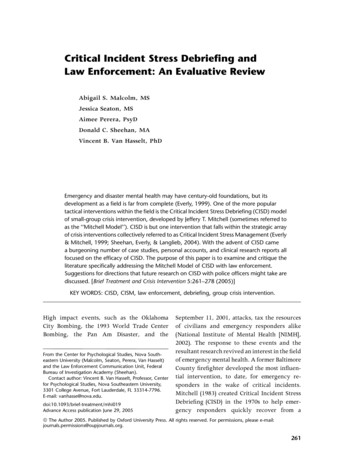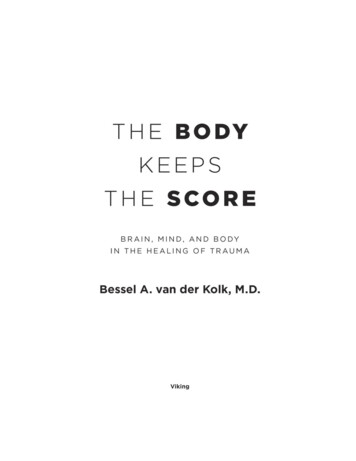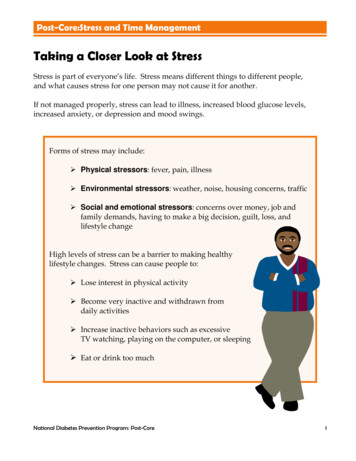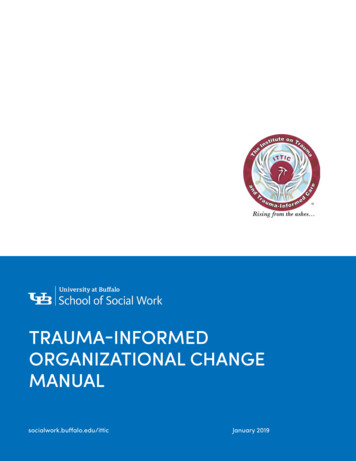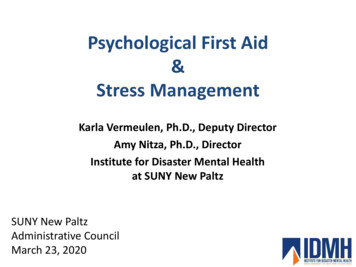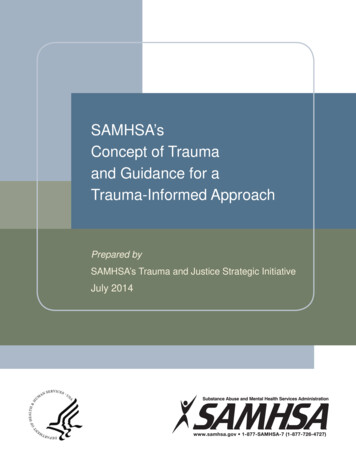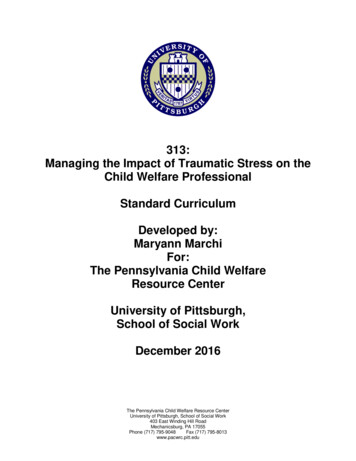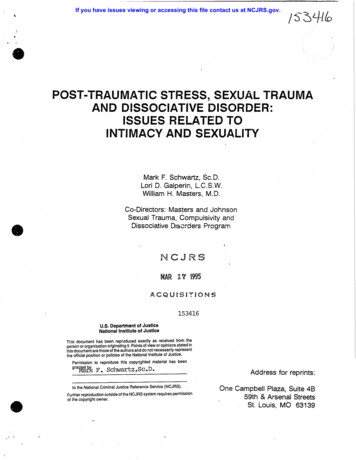
Transcription
If you have issues viewing or accessing this file contact us at NCJRS.gov. POST-TRAUMATIC STRESS, SEXUAL TRAUMAAND DISSOCIATIVE DISORDER:ISSUES RELATED TOINTIMACY AND SEXUALITYMark F. Schwartz, SC.D.Lori D. Galperin, L.C.S.W.William H. Masters, M.D. Co-Directors: Masters and JohnsonSexual Trauma, Compulsivity andDissociative Dlscrders ProgramNCJRSMAR Jl.1 1995ACQUISITIONS153416U.S. Department of JusticeNational Institute of JusticeTilis document has been reproduced exactly as received from t eperson or organization originating it. Points of view or opinions stated Inthis document are those of the authors and do not necessarily representthe official position or policies of the National Institute of Justice.Permission to reproduce this copyrighted material has beengra F. Schwartz,Sc.D.to the National Criminal Justice Reference Service (NCJRS). Further reproduction outside olthe NCJRS system requires permissionof the copyright owner.Address for reprints:One Campbell Plaza, Suite 4859th & Arsenal StreetsSt. Louis, MO 63139
SECTION 1: STRESS RESPONSE CYCLES, D!SSOCIATION AND SEXUALITY:INTRODUCTIONWhen overwhelming stressors occur acutely or chronically, the natural biphasicresponse, both psychologically and physiologically, is numbing, avoidance, amnesia andadhedonia that cycle intermittently with intrusions of affect and memory, hyperreactivityto stimuli and traumatic reexperiencing (Horowitz, 1986). During the numbing phasethere will be avoidance, detachment, emotional constriction and depression. Becauseof the high level of fear and avoidance, there is time-limited gradual revisiting of theevent, directly or indirectly, until it is mastered or completed. Inability to work throughthe overwhelming experience successfully (as might occur in the case of traumatizedyoung children without supportive nurturing parents) may result in intrusions. Theseintrusions may take such forms as visualizations of the event, a "bleeding throughll of intense affect such as sadness or fear on a chronic basis and/or a tendency torecapitulate aspects of the trauma developmentally - "dedicating" one's life to reliving theevent in disguisEJd forms. Physiologically, the system will cycle with hyperarousal stateswhich the individual may experience as terrifying or exciting. as well as providing a relieffrom the depressed, numbing, constricted states.Hypo- and hypersexuality mayalternate concomitantly with these changes.When trauma has included sexual abuse or rape, the numbing and intrusionsymptoms typically involve body sensations and somatic complaints, as well as sexualdesire, arousal or orgasm. In addition, if the violation is by a caregiver or by an olderperson towards a child, there commonly are developmental influences to the unfolding sexual and affectional systems. Traumatized individuals may develop a sexual desire1
disorder with hypo-, hyper- or asexuality. Hyposexuality is evidenced by low initiatorybehavior, while hypersexuality employs frequent sexual in:!:ation as a means of dealingwith most negative affective states, including loneliness, fear and sadness. Asexuality typically results from extreme fear of bonding with others, extreme narcissism whichresults in an inability to genuinely care for or empathize with others and/or severerepudiation of one's genitals, sexual arousal or gender. Often individuals with hypo-,hyper- and asexualities will utilize imagery to distance themselves from others andthereby deal with fears of intimacy.Frequently hypersexual individuals will becomehyposexual as their alexithymia is reversed, and they consciously experience fearsrelated to bonding.Mediating the link between trauma and sexuality is the phenomenon ofdissociation.Dissociation is a safety-oriented cognitive mechanism in which theindividual attempts to avoid memories or affect that "disrupt the psychic equilibrium"(Wilson, 1989). With dissociation there may be reality detachment - events are perceived without emotions, the self becomes robot-like and others are depersonalized objects.Since the individual feels like an object, he or she may be able to respond sexually, evento the point of orgasm, by IIbypassing" desire or arousal. These men and women areable to have sex with the other person's body without affection, intimacy or even likingthe partner, by focusing on body parts such as breasts or genitals rather than on thewhole person.In effect, they are using the other person's body to masturbate.Alternatively, they may fantasize a pornographic scene and have sex with a fantasypartner rather than the person. Thus, dissociation serves the function of distancing them2
since becoming too close or dependent on others may be registered by the traumatizedindividual's brain as dangerous.Also, distancing oneself allows the individual tomaintain the depersonalized state, and therefore not think or feel about past traumaticevents.Dissociation also involves partial or complete memory loss, misperception,misappraisal or misattribution of ongoing events (Briere, 1992). The individual mayIIspace-outli or shut down or act or look like they are feeling when they are not. Thedissociation allows analgesia and protection both during the post-traumatic event andlater, ensuring that the victim maintains a sense of control. even though events are inreality out of control. Sexually, the body may experience analgesia and the hyposexualindividual may report that they IIfeel nothingll. Van der Kolk (1989) has reviewed the extensive literature of endogenous opiods secreted chronically after prolonged exposureto severe stress. In veterans, he documented opiod-mediated analgesia two decadesafter the original trauma, which was equivalent to a secretion of eight milligrams ofmorphine. Touching a partner following a period of early prolonged or extreme traumaor neglect may therefore be experientially blunted like touching an inanimate object.There also may be genital anesthesia. Erection and lubrication may be inhibited by theterror, which the individual is not consciously experiencing. Also, the individual in anover-controlled state may be unable to IIlet go" and therefore any accumulatedvasocongestion may not result in orgasm.Braun (1990) has conceptualized dissociation of behavior, affect, sensation andknowledge (or cognition) as the BASK model. 3Examples of behavior include
disorientation to place or person or to visual, auditory or tactile cues.Sexually,examples include men who perform anonymous sex with strangers whom they often donot like or find attractive, men who put their penises through holes, without knowing who is on the other side, for the purpose of ora! genital contact, or women who functionrepeatedly as prostitutes.Typically, such dissociated behavior is trauma-bonded(Schwartz. Galperin & Masters, 1993) - i.e., the compulsive behavior serves as areenactment of the original trauma. A part of self will revisit the experience of childhoodrape repetitively, to repeat the danger and excitement, in an attempt to complete thestress response cycle.Dissociation of affect might include experiencing feelings of terror, numbness orconfusion w thout any apparent cause, or affect incongruent with the present situation.Endemically, many men in this culture highly dissociate from affect, unaware of a myriadof emotions. Feeling distance and disconnection from their partners is experienced asa need for ejaculation. Some individuals can have sex without affection because of dissociated affect. On the other hand, a person might experience sexual apathy orimpotence because the individual is terrified but unaware of it. Unable to use fear orterror as a signal, some individuals attempt to "perform", but the genital vasocongestionis blocked by the fear.Dissociation of sensation may include numbness, headaches or sickness or painin the pelvis with no medical explanation.As stated, one may touch their partnersexually and have the same experience as touching an inanimate object - numbness.The sensations of the body with sexually traumatized people are particularly prone to4
dissociation because these individ'.Jals may believe the body is the source of theirbadness (Le., it's because of my body or my sex organs that I was raped). The latterwould be an example of knowledge that has become dissociated. Other examples ofdissociated sensations that are common are out-of-body experiences such that theindividual "l eaves II their body during sex and watches from the ceiling, thus feeling numb.Dissociated knowledge might be manifested by the belief that a rape didn'thappen to lime", it happened to the body. or to the genitals as a way of coping with theoverwhelming terror.The cognitive system shuts down, and the individual thendisengages each time he or she has sex and lends the "body" to his or her partner. Thisexemplifies another critical component of dissociation, which is fragmentation ofpersonality. vVhenever a traumatic situation occurs, the event is encapsulated by the dissociative process and a semi-permeable membrane develops around the event thatonly allows some information in and out. For example, if a child is age six at the timeof sexual abuse, there will be an encapsulated trauma-bonded six-year-old-self that isimpervious to future development (Schwartz, Galperin & Masters, 1993). This part of selfis described by Watkins and Watkins (1988) as an ego-state. Encapsulated within theego-state is cognition, affect, sensation and knowledge of the six year old. When traumais very severe and/or occurs at a young age, the ego states are even more distinctiveand become the alter personalities of the patient with a dissociative identity disorder(DID). This ego state or alter may believe that it can still be raped at any moment, thatdanger is imminent and they are at fault. Typically, when there is severe early trauma,there is a robot "depersonalized" part of self that has endured the rape, and an affective 5
part of self that holds the rage and sadness unable to be expressed. Two additionalparts usually manifest themselves following severe trauma. There is a part that takescare of the person which developed when no caretakers were available, and an executive part that functions to please, caretake and go to work. This part is highlyreactive to others.Because of this compartmentalization of personality, which once allowed theindividual to survive, there now are parts of self. that .may have. conflicting needs. Forexample, one part may want sex, but another is terrified of sex, and still another isrageful about repeatedly being treated unfairly.These parts of self may actautonomously to encourage self-destructive behavior which the executive part of selfmay know will lead to harm of the self or others. Thus when a loving, caring partnerapproaches the person for a relationship, another part may sabotage the buddingrelationship to protect the individual from anticipated abandonment or pain.Since parts of self may have limited information because of amnesic and dissociated awareness, they can interpret their needs only narrowly relying upon thelogic of the encapsulated abandoned child.When the parts of self feel sad, theexecutive self may get a signal to eat; or if they feel lonely, the signal may be to havesex; or if they become terrified, the executive may be urged to seek drugs or alcohol.Thus, strong emotions may trigger addictive behavior even when the consequences tothe executive adult self are destructive. Emotions may trigger unresolved, unmetabolizedpast trauma, causing a leakage or intrusion of the cognition or affect into consciousness.The individual will feel out of control and reinitiate the illusion of control by obsessional6
thoughts or compulsive behavior. This "illusionll is the momentary, extremely reinforcingand quite likely endorphin-releasing experience that results from revisiting the illicitdanger. Thus, the obsessions and compulsions provide a relief from the pervasive painof disconnection and chronic dysphoria. The acting-out behavior and revictimization ofself is a form of "physiologic masochism" which is one of the long-term effects of severeearly abuse and neglect. Ultimately, resolution of past trauma and integration of the splitoff parts of self are essential to stop the numbing and intrusion cycles and resultant selfdestructive behavior.SECTION 2: SEXUAL UNFOLDING AND THE DEVELOPMENT OF LOVE MAPSSexual desire, arousal and orgasmic response are natural functions that unfoldboth physiologically and psychologically throughout childhood and adolescence. Each person follows his or her culture's script that dictates sexual desire in specific situationsand stimulates sexual response to certain individuals and images. John Money (1986)has used the term "Iove mapl' to describe such images and behavior:A love map is not present at birth. Like a native language. itIt is adifferentiates within a few years thereafter.developmental representation or template in your mind/brain,and is dependent on input through the special senses. Itdepicts your idealized lover and what, as a pair, you dotogether in the idealized, romantic, erotic and sexualiz.edrelationship. A love map exists in mental imagery first, indreams and fantasies, and then may be translated into actionwith a partner or partners.The factor that initially influences love map development during childhood is thepresence or absence of adequate parenting, caretaking and nurturing.' These, in turn,strongly influence the capacity to master the environment, self-efficacy, self-esteem and 7
the ability to establish and· maintain close attachments. Adequate parental or substituterole models allow a person's gender identity to unfold within established cultural scripts.Social interaction with peers provides skills and integral feedback for developing affectional systems. Genital rehearsal by self-touch and exploration of bodily sensationsthen provides individual biofeedback, which allows the person to integrate his or herunfolding sexuality with developing personality.Love maps may be "vandalized" (Money,. 1.989) by. "sex-negative'! antecedentswhich are "traumatic, disciplining or stigmatizing". Traumatic antecedents may resultfrom rape, molestation or from witnessing family members being sexualiy abused.Discipline may occur verbally or physically by punishing "natural" manifestations ofsexual unfolding such as masturbation.Stigmatization may result from perceivedshaming, ridiculing, isolation or selective treatment of an individual because of their bodyor behavior.As a person matures, sexual desire and arousal can become a natural manifestation of attraction to a person perceived as appealing if the developmental lovemap is not seriously vandalized.Once a pair-bond is established, sexual desire is a natural way of expressing thesense of intimacy that develops within a committed relationship.T lerefore,anythingwhich enhances or inhibits relational intimacy may positively or negatively influence theindividual's levels of sexual desire or arousal.Sex is innately pleasurable - unlesssomething mitigates that pleasure. Also, persons who are situationally bored, pressured,fatigued, angry, guilty, fearful, anxious or suffocated in a relationship are "entitled" to low8
levels of sexual.arousal (Apfelbaum et aI., 1979). Couples who evidence little intimacyin the living room typically will feel distant from each other inside the bedroom, unlessimpersonal sex or conflict has become a source of arousal. Often individuals with ahistory of trauma find partners who also have experienced severe trauma (Carnes, 1992)and then develop a history of destructive transactions between themselves whichinterfere with sexuality even more.Vandalized Love MapsLike native language, the social and sexual customs of a culture are programmedin after birth into an actively differentiating central nervous system. Sexual behaviorseems to remain in a state of hibernation which can be awakened at different agesdepending on the individual or the culture. Typically there are individual genitalrehearsals before age 5 and erections and vasocongestion of the pelvis are normative(Schwartz, Money & Robinson, 1981), particularly with adequate holding, touching andnurturing from caregivers (Spitz, 1945). The pubertal hormones then activate the lovemaps which have developed throughout the first decade of life. Social customs such asthe recent deluge of media related to sexual behavior and romance may stimulate theprogram earlier. The trends for initiation of teenage sexual intercourse have changedradically since 1950, so that it is normative for boys and girls to initiate sexual play soonafter puberty. It has also been hYPothesized by Money (1986) that sexual stimulationmay alter the brain, as evidenced by the age of puberty decreasing over the past fortyyears as kids are sexualized earlier. 9
Sexuality can also awaken prematurely due to sexual trauma. The sexualizedchild will often have sexual urges too early to integrate into the developing personalityand without cognitive preparation or guidance.It is as John Fowles described metaphorically, "like a ship sent out to sea without a rudder". Thus, like a child who hasprecocious puberty, the sexualized child finds that socializing with same age peers isuncomfortable and therefore remains isolated and vulnerable to atypical socialization andrevictimization by destructive sexualized relationships.Whenever sexuality awakens within a context of e?Cploitation, hatred, violence orshame, it is disruptive to the basic schemas of cognitive development of the child esteem, trust, safety, power and intimacy (McCann & Pearlman, 1990). Development ofthe capacity for empathizing with others is also impaired, and so, the child remains thecenter of its universe. With trauma and in the absence of emotionally relevant socialsupport, both the core sense of self and the idealized internal representation of thecaretakers are disrupted. This results in the individual clinging to idealized object andgrandiose self-relation units for self-preservation (Barnard et aI., 1992). All theseimpaired developing cognitive systems influence social relations, intimacy, sexuality andthe capacity to pair-bond. Additionally, the sense of self is organized around sexualstigmatization and shame, i.e., I'm different, defective or injured because of my gender,body or sexuality. Therefore, activation of sexual arousal elicits sexual shame so theperson is reminded that they are "bad" because they feel sexual, or because they havegenitals or because they are male or female.10
The following description from a taped therapy session with a sexually compulsiveego-state (discussed in the previous section of this paper), accessed under hypnosis,clearly depicts how parental neglect can influence the developing love map of a sevenyear old boy. This individual presented in therapy as an adult with compulsory sadomasochistic sexual behavior with a prostitute. Under hypnosis, the client scanned for"any event that can help you understand your arousal to having pain inflicted upon you".He remembered his mother leaving frequently for extended periods and her multipleaffairs. The following is his "encapsulated distorted" thinking about sexuality:.' Sex is dirty. It feels good but I don't want no part of it. Itonly makes life miserable. Your penis will fall off if you havesex too often. All it's good for is causing trouble. You can'tfeel sex, you can only hurt it. After all, my Mom uses it tofuck my Dad and Billy. That's all the men are good for, soMom can fuck them. Well, fuck them all, I don't want sex.It's evil and good for nothing. It only makes me feel bad. It'swhy Mom is never home, she's out fucking and hurting men.I wonder if she has other kids. I hate sex. If I cut off mydick, Mom would like me better. She hates boys - she justwants their dicks. She keeps them on her trophy shelf. Billyand Dad are fools. They think she wants their stupid uselessdicks. Well, everyone knows that they're ugly and should becut off. I'd cut yours off if Mom asked me too. After all,what's it good for? It just gets you in trouble. That's whyMom liked my sister Julie more. She doesn't have a dick.Girls always call the shots - you can't put your stupid dickinside of them unless they let you. And they only let you ifyou beg and plead. And you're good at that - because youcan only please Mom by giving her your dick. She makesyou such a fool. Sex is her toy to enslave me. She uses itto control Billy and my Dad. And they hate her, but becauseof sex, they are tied to her. What weaklings they are. If theywould stop wanting to have sex, then she could not controlthem. They're like robots, she pushes their buttons with sex.They're idiots and deserve what they get. She doesn't doanything and they follow her sex smell because they have nobrains. I like beating off wit Billy. The sperm goes right11
where;: belongs - in the toilet. I always want Billy to beat meoff - he really does it good. See, sex is dirty, but we need itto survive.Serves him right - she was just a cocksucking tease. Shemade us beg for her attention and then she just took ourdicks off. That's all we are to women - just a sex thing forher to torment. We deserve the torment, deserve thelaughter. The client's love map which includes sexual desire and arousal to havingprostitutes verbally and physically abuse him,.seems to follow directly from.the childhoodexperiences of (1) extreme neglect by both parents, (2) mother frequently abandoningthe children and having frequent sexual affairs, and (3) confusion over her lover, Billy,moving into the house while the father lived there.He needed his mother who heperceived as wonderful and she hurt him, while his father seemed pitiful and neglectful,which led to his repudiating aspects of masculinity and eventually cross-dressing as achild.From this example, it becomes more obvious that integrally involved in the love map is one's gender identity and sense of self as masculine, feminine or ambiguous.Optimal parental and other role models allow a person's gender identity to unfold withinestablished cultural scripts. Genital rehearsals, including self-stimulation, fantasy andsexual play, as this example suggests, allow the person to integrate his or her unfoldingsexuality and developing personality.SECTION 3: THE IMPACT OF SEXUAL ABUSE ON UNFOLDING SEXUALITY: THEEXPERIENCE OF SEXUAL TRAUMAWhen an individual has been sexually abused as a child the only framework heor she has for sexuality is one whose components are brutality, sensation out of control,12
overwhelming confusion, violation and ambivalence - particularly if the abuse was at thehands of someone upon whom the child relied. The natural unfolding of sexual curiosityand interest at developmentally appropriate intervals would have been preempted by apremature awakening of genital eroticism beyond a child's capacity to comprehend ormanage.Sexuality unfolding for the first time in the context of rape would be likeintroducing a child to dogs by having a doberman maul him/her. The child, when yousaid the word IIdog" to him would not think of a cute, .cud.dly, benign puppy,. butremembering his own experience, would feel terror and fear for his life.If his firstexposure was traumatic in this way, the fear would likely generalize to all dogs, toanything called "dog ll ; anything vaguely resembling that doberman and the child'sresponse would predictably be an aversion. When a child experiences sexual abuse, there is overwhelming confusion. Notonly can the child not make sense of why this is being done to him/her, but likewise thechild can make no sense of the myriad, sometimes conflicting sensations caused bywhat is happening. Further complicating matters, perpetrators of child sexual abuseoften say things in the course of the abuse or just after such as: 13
I know you liked that.You're a bad/naughty little girl/boy.I do this because I loveYOLl -you're my special one. This is good for you.Now you'll know what not t() do.I have to do this to teach you a lesson.Your mother won't do this, so you .have to . ,You're a little whore; that's all you'll ever be.The child often construes the sexual abuse as punishment and wonders what he or shemust do to be better so as to avoid this horror in the future. When child sexual abuseoccurs at the hands of a parent, the internal conflict the child experiences is of an evenmore immense proportion. Because the child must depend on his or her parents for allforms of sustenance - literally for life itself - the child even more conclusively blameshimself for what is happening. The bodily sensations are themselves terrifying. The child no longer has controlof his own body - he learns that at any time a more powerful other can appropriate hisbody and make it act in any way he (the perpetrator) chooses. He learns that bodilyresponses too complex to comprehend can be evoked from him entirely at the whim ofanother and that he is and can at any time again be at the perpetrator's mercy. Hisbody is never again his own - it's a defecter gone over to the other side - it betrays him.Now he is at war with his own body.14
Some of the confusing sensations may feel pleasurable, and this makes the childfeel ambivalent. He may feel ashamed of his body's response as though perhaps it'strue he has done something (as the perpetrator implies) to make this thing happen tohim. If he lives in a family where no one touches anyone in a loving, healthy, comfortingway then he is already starved for touch, since it is a most basic human need. Whenthis annihilating touch with its fleeting moments of pleasant sensation is the onlyavailable tactile human connection, the child may indeed.learn.to·seek it out eventually.In no way would this constitute the child desiring to be raped, but rather reflect thetremendous environment of deprivation against the backdrop of which the abuse takesplace. The child may likewise learn that compliance makes what is inevitable less brutal,i.e. he doesn't have to be beaten, burned, choked or smothered into submission if he'll just lie there and let the perpetrator have his way .Splitting and Di sociationAs a consequence, the child may initially attempt to focus only on what ispleasurable. Since this is like searching for a needle in a haystack, the child usually willof necessity find some mechanism of splitting off from the body to which the abuse ishappening. The child may sing to himself, put himself in trance by repeating a word orphrase, do multiplication tables in his head, focus on the colors he can see as thoughentering into those colors. The following is one individual's dissociative trance followingher parents' slaughtering of her dog Petey and sexually abusing her. She was told thatthe dog was killed because she wouldn't lie still. It was because i couldn't lay still when she was putting thatthing in my pee-pee. I sat in my bed eating chips and15
wondering who was going to help me, eating peanut butterto take the taste of her pussy out of my mouth, eating morepeanut butter because I can't get the taste of Petey's bloodout of my mouth. Counting all the holes in the ceiling,wondering who I was going to talk to, eating handfuls of rawoatmeal, wondering who was going to sit with me in thewindow, wondering if I'd really, really had enough goodnessin me to lay really still. I remember eating peanuts one byone counting them as I went 380 peanuts all together. I atethem. It was ending the loneliness and guilt for having Peteyslaughtered in front of my eyes. Watching his throat beingsliced and 380 peanuts later I decided it was my fault, and Iwanted my mouth to be drenched in his blood, in .my mouthI wanted to be back in the blood, I was bad. I felt like I wasa fat bitch and I felt guilty for having the need to eat thecandy, I didn't deserve to have the food I had, I was verybad, 12 x 12 144,12 x 6 72, 12 x 3 36 - half of half.I wanted to cry, because I didn't have any tears I was afraidto cry, I hated the idea of who was going to protect me aftermy father left my bed at night, Who was going to be there topet when they broug.ht back to the house in the wee hoursof the morning, Who was going to lick my face and make megiggle, No one I was alone, totally alone 12 x 4 48, 6 x 6 36 - no one. I want to cry but I'm afraid - I'll eat that'swhat I'll do I'll eat this and it will make me feel good to havethis in my belly. If the abuse becomes more torturous, as in this example, the numbing and splitting offfrom bodily sensation must by necessity become more extensive. The child feels himor herself float up and look down from the ceiling with detachment at the poor childbeing raped on the bed. When sexual abuse is brutal and frequent and the child hasless and less hope of actual escape or rescue, the splitting must be used as a habitualcoping response. The child, if imaginative, may create a substitute child out of thisexperience of trauma-induced depersonalization. As he has the experience that manyrape victims describe of standing or floating outside of t'1e violent proceedings, he findsit self-preserving to imagine that the child he sees being brutalized is not him. In this16
manner the child's desperate attempt to convince himself that: "it's not happening" givesway to "well, at least it's not happening to me". With continued abuse, the split becomesstrengthened, the personality fragmentation more rigid. The part of self perceived asseparate may encompass and contain part or all of the child's memory and responseto the abuse, leaving the child free to function semi-normally or at least with lessdevastating impairment. The child may perceive this part of self as bad but separate,and after even more abuse rigidifies the barriers to conscious perception, the child mayeven cease to perceive the presumed "other" at all. When
individual's brain as dangerous. Also, distancing oneself allows the individual to maintain the depersonalized state, and therefore not think or feel about past traumatic . and become the alter personalities of the patient with a dissociative identity disorder (DID). This ego state or alter may believe that it can still be raped at any moment .


